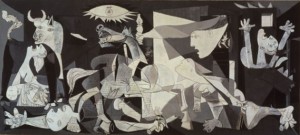Art and War: A New Series
Amelia Grabowski, Education and Outreach Specialist
I wanted to start this blog post with a dramatic quote about art in wartime, but when I Googled “Art and War quotes” what I got instead was a variety of Sun Tzu quotes and a few from Game of Thrones, so I suppose I’ll have to be dramatic all on my own.
War is a time of incredible loss and destruction, violence and division, the effects of which are felt generations afterwards. As individuals and as a society, we find ways to grapple with destruction and loss, to make peace with it and to mend where we can. We see this in Clara Barton’s story: by braving the battlefield as a nurse, calling upon her wartime connections to bring closure to the families of missing men, and using her knowledge and clout gained through her Civil War experiences to found the American Red Cross and to lobby for the United States to ratify the Geneva Convention.

Picasso’s Guernica, an example of art that grapples with and interprets war.
We also see this grappling in art. Whether visual art, the performing arts, literary arts, or music, art is a way we reckon with what we’ve experienced; whether to bear witness, find meaning, or simply move on. In this series, each Monday, we will feature one such piece of art (visual, performing, literary, or musical).
Our inaugural work is a poem, Walt Whitman’s Not Youth Pertains to Me:
NOT youth pertains to me,
Nor delicatesse—I cannot beguile the time with talk;
Awkward in the parlor, neither a dancer nor elegant;
In the learn’d coterie sitting constrain’d and still—for learning inures not to me;
Beauty, knowledge, inure not to me—yet there are two or three things inure to me;
I have nourish’d the wounded, and sooth’d many a dying soldier,
And at intervals, waiting, or in the midst of camp,
Composed these songs.

Walt’s younger brother was wounded at the Battle of Fredericksburg. Fearing the worse, Walt rushed to his side, which brought him to a mansion-turned-hospital in Virginia. There Whitman discovered that his brother was alright, but that he couldn’t ignore the suffering of others. Whitman became a “volunteer nurse,” or in his words a “wound dresser.” Like Clara Barton, he assisted where he could, which often meant talking to the wounded soldiers and comforting them, first in Fredericksburg, then in many of the military hospitals in Washington, DC where he lived.
Walt’s work in the hospitals filled both his free time and his poetry, as evidenced in his 1871 poem Not Youth Pertains to Me. In the poem, Whitman lists what defines him: attending the Civil War wounded, then writing about it.
What strikes you about the poem? Tell us in the comments.
Learn More about Whitman’s Poetry
Tags: Art and War, Fredericksburg, Nurse, Poem, Poetry, Walt Whitman, Whitman Posted in: Art and War
